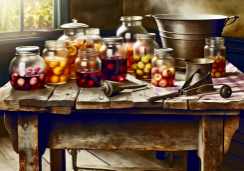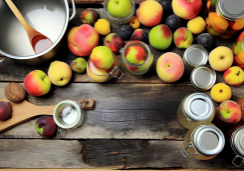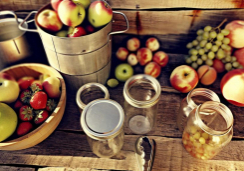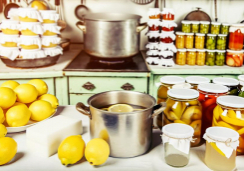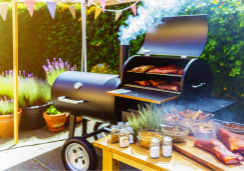Why Choose Classic French Techniques in Home Cooking?
Much like an artist reveres the Renaissance, a home cook often looks to classic French techniques for culinary inspiration. You understand that the revered methods of Escoffier and Careme aren't just for the bustling kitchens of Michelin-starred restaurants; they're accessible tools to elevate your daily meals.
By incorporating skills like mastering the five mother sauces or perfecting your julienne, you're not only paying homage to centuries of culinary tradition but also enhancing the flavors and presentation of your own creations.
While you might feel a bit daunted by the precision and discipline these techniques demand, their benefits to your cooking repertoire are undeniable. Imagine serving dishes that not only satisfy the palate but also carry the weight of a storied gastronomic heritage.
As you contemplate the leap into this refined world of cooking, consider the satisfaction and depth of knowledge you'll gain, making every future meal an opportunity to showcase a touch of French elegance.
Historical Significance of French Cuisine
Delving into the historical significance of French cuisine reveals a tapestry of culinary innovation stretching back to the Middle Ages, where each dish tells a story of social and political transformation. The French Revolution, in particular, was a turning point, democratizing food and flavors that were once exclusive to the aristocracy. This upheaval paved the way for a new era in the art of French cooking.
A brief history of classic French gastronomy can't omit the legendary Georges Auguste Escoffier. He revolutionized French cooking techniques, elevating them to an art form with his meticulous methods and the introduction of the kitchen brigade system. This brigade system organized the kitchen into specialized stations, streamlining operations and setting the standard for professional kitchens worldwide.
Your appreciation for French cuisine deepens when considering pioneers like Pierre La Varenne, who authored 'Le Cuisinier François' in 1651, laying the groundwork for modern French culinary practices. It's through these historical lenses that you can see how classic French dishes, such as coq au vin and bouillabaisse, aren't just recipes but storied classics that have weathered centuries of change while retaining their exquisite flavors and techniques.
Essential French Cooking Techniques
Mastering the art of French cooking begins with embracing essential techniques that transform simple ingredients into culinary masterpieces. At the heart of your journey is mise en place, the methodical approach to prepping and organizing cooking ingredients before you begin. Coined by Georges Auguste Escoffier, this practice not only saves time and stress but reflects the meticulous French attitude towards cooking.
Your knife work is paramount; it's more than just chopping—it's an art form in French cuisine. The precise cuts you make affect everything from the appearance to the texture, cooking time, and flavor release of your dishes. It's vital to use a sharp knife for consistency and precision.
Embrace the tourne technique that involves crafting vegetables into uniform, elegant shapes—a tradition born from Antonin Carême's creativity. This not only showcases your skill but also pays homage to the elaborate and extravagant dishes of classic French cuisine.
Don't shy away from the dynamic world of French cooking techniques: the sizzle of ingredients in a hot pan over high heat when sautéing, the dramatic flare of flambéing, the gentle simmer of poaching, or the transformative magic of braising on low heat. Each method is a step toward mastering the storied craft of French cuisine.
The Five Mother Sauces Explained
At the core of French sauce-making lies the mastery of the five mother sauces—Béchamel, Velouté, Espagnole, Hollandaise, and Tomato—each a gateway to a myriad of exquisite flavors and culinary creations. These staples aren't just sauces; they're the quintessential Fundamentals of French Cooking, pivotal for anyone delving into the culinary arts.
Béchamel, a velvety white sauce, begins with a roux of butter and flour, to which milk is added. It's a creamy canvas, used in French lasagnas and moussaka, that enhances the flavor of dishes with its rich base.
Velouté, similar in technique but made with light stock, is equally versatile, often serving as the starting point for elegant gravies and soups.
The robust Espagnole, enriched with brown stock, tomatoes, and a mirepoix of vegetables, adds depth to stews and braises.
Hollandaise, an emulsion of egg yolks and butter, gently warmed and whisked, brings a luxurious touch to vegetables and eggs.
Lastly, the bright and versatile Tomato sauce, cooked down from ripe tomatoes, herbs, and sometimes stock, is a foundation for countless Mediterranean and French country dishes.
Embrace these sauces, and you'll unlock an essential aspect of French cuisine, turning your home cooking into a showcase of layered flavors that any chef would applaud.
French Culinary Influence on Home Cooking
French culinary techniques, with their meticulous organization and precision knife work, have transformed the way we approach home cooking, instilling discipline and an appreciation for the art of cuisine in kitchens around the world.
The French style of preparation, particularly the mise en place, sets the stage for a seamless cooking experience. Before you even start cooking, every ingredient is chopped, measured, and placed within easy reach, a method that's as practical as it's emblematic of modern French efficiency.
Knife skills, honed through classic French training, elevate your dishes with cuts that enhance both appearance and flavor. The elegant tourne cut, for instance, isn't just about aesthetics; it's a nod to the art form cultivated by French chefs like Antonin Carême. By adopting these techniques, you're not just making a meal; you're crafting an experience.
When you sauté, flambé, or braise in the French tradition, you're participating in a rich legacy that extends beyond the bustling kitchens of French restaurants. French cuisine is renowned for its influence, and by bringing these methods into your modern kitchen, you're continuing a culinary conversation that has inspired generations.
Mastering French Techniques at Home
Building on the foundation of French culinary influence, you can now bring the precision and elegance of classic techniques right into your own kitchen. Often referred to as the 'king of chefs and chef of kings,' French cooking is a testament to meticulousness where 'everything in its place' means everything. You'll need to know the ins and outs of your ingredients and tools, ensuring they're 'ready to go' before the actual cooking begins. This concept, known as mise en place, sets the stage for a seamless culinary performance.
Diving into French techniques, you'll discover that the mastery of knife skills is paramount. Precise cuts can be traced back to the storied kitchens of France, where uniformity isn't just for show—it's for cooking everything to perfection. Whether you're sautéing with oil or butter, your ingredients will cook evenly, enhancing flavor and texture.
The tourne technique, a classic French cut, turns ordinary vegetables into elegant, seven-sided morsels. It's this attention to detail that can elevate your home cooking to new heights. As you practice and perfect these skills, you'll find yourself not just preparing meals, but crafting edible works of art steeped in tradition and finesse.
Frequently Asked Questions
What Is so Special About French Cooking?
You'll find French cooking special for its sauce mastery, precision cuts, and flavor layering. It's all about butter usage, strong culinary foundations, perfect mise en place, refined dough techniques, and artful presentation.
Quelles Sont Les Techniques De Cuisine Françaises Importantes ?
You'll master French cooking by nailing mise en place, roux making, and sautéing basics. Learn chiffonade cutting, béchamel preparation, consommé clarifying, and sous-vide introduction, not to mention pâtisserie essentials.
Why Do We Use French Words in Cooking?
You're using French cooking terms because they denote a rich linguistic tradition and prestige in the culinary lexicon. These universal terms reflect heritage influence and are the educational roots of the professional standard in gastronomy.
Why Is French Gastronomy Important?
French gastronomy's importance lies in its historical significance and cultural impact. You'll find its culinary legacy and gastronomic heritage shape flavor foundations worldwide, with a strong emphasis on artisanal approaches and precise techniques.
Conclusion
Embrace the time-honored art of French cooking to transform your kitchen into a hub of culinary excellence. Mastering the foundational techniques like mise en place and knife skills, you'll craft meals with finesse.
Understanding the five mother sauces elevates your dishes to new heights of flavor. By incorporating these classic methods, you'll not only pay homage to a rich culinary heritage but also impress loved ones with your gastronomic prowess.
So, channel your inner chef and let your culinary journey begin!




